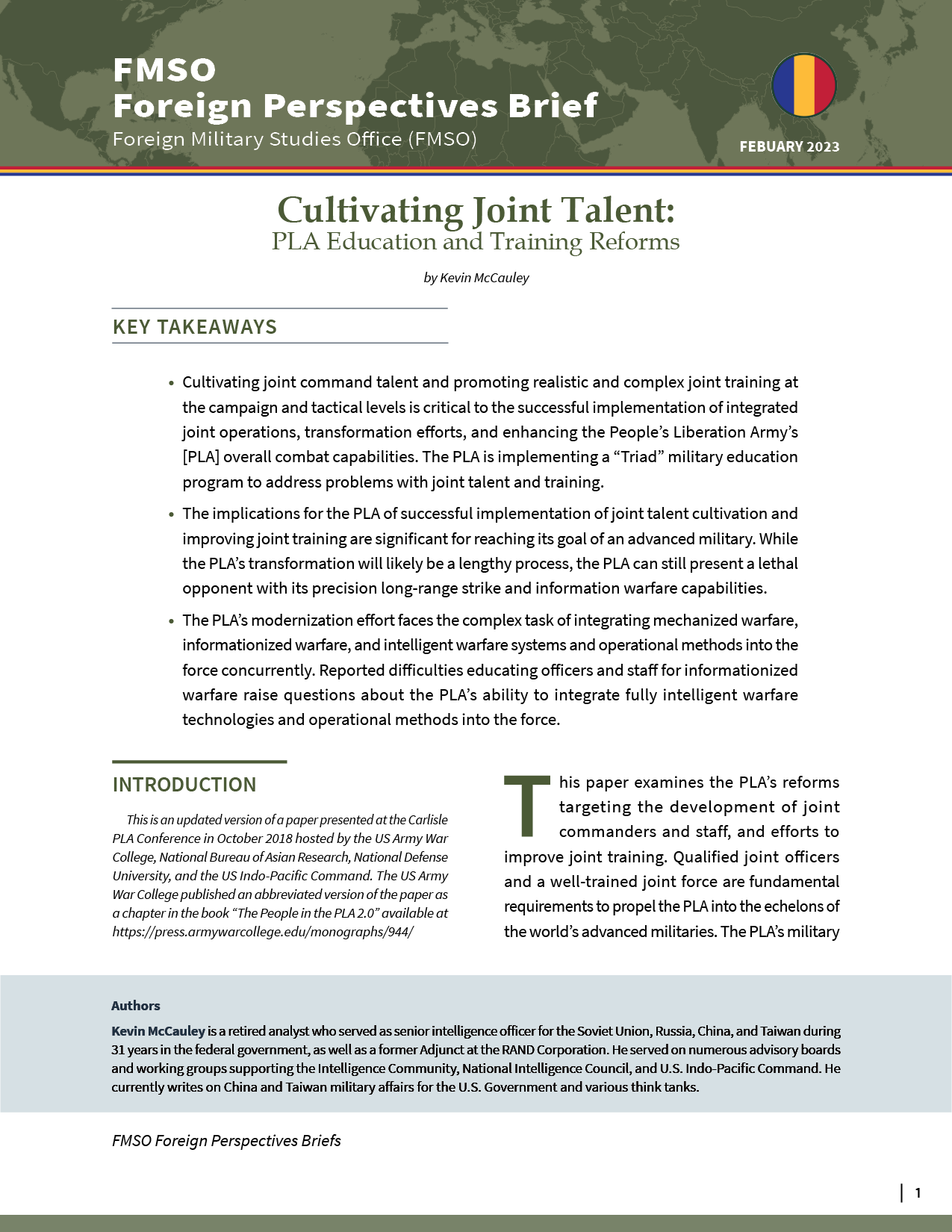Integer Quid Ser
Monthly Archives: February 2023
“India Takes a Step Way from the Russian Defense Industry” By Matthew Stein (August 2023)
India and Russia have had a long-standing security cooperation partnership, with India relying heavily on Russian weapons and equipment for its armed forces. However, Indian Prime Minister Narendra Modi launched the Make in India initiative in 2014 to develop the country’s defense industry and reduce dependence on imports. The war in Ukraine has caused India to accelerate this process and end negotiations or cancel agreements with Russia on several weapon system acquisitions. Indian officials cited Russia’s logistical problems in delivering new systems as the reason for the cancellations. This article examines how the conflict in Ukraine has impacted one of Russia’s key security cooperation partnerships and how India’s defense industry is developing to produce replacements for these systems. The study provides insights into the challenges and opportunities for India to achieve its goal of self-reliance in defense production.
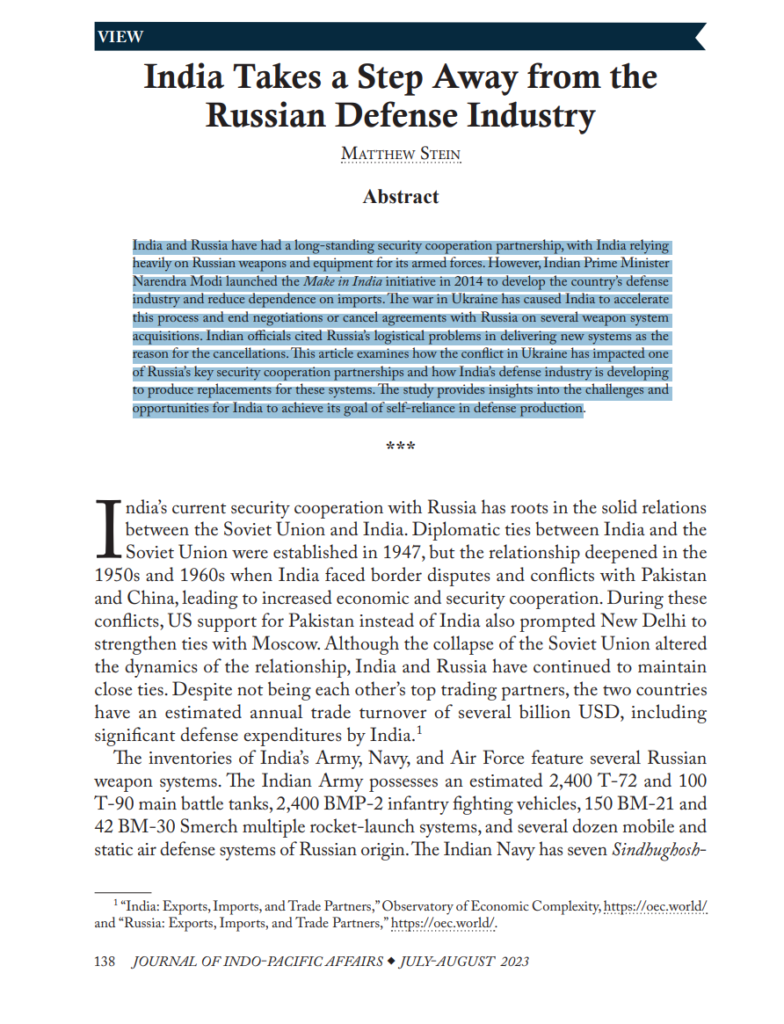
Cultivating Joint Talent: PLA Education and Training Reforms (Kevin McCauley)(February 2023)
(Click image to download brief.)
KEY TAKEAWAYS
- Cultivating joint command talent and promoting realistic and complex joint training at the campaign and tactical levels is critical to the successful implementation of integrated joint operations, transformation efforts, and enhancing the People’s Liberation Army’s [PLA] overall combat capabilities. The PLA is implementing a “Triad” military education program to address problems with joint talent and training.
- The implications for the PLA of successful implementation of joint talent cultivation and improving joint training are significant for reaching its goal of an advanced military. While the PLA’s transformation will likely be a lengthy process, the PLA can still present a lethal opponent with its precision long-range strike and information warfare capabilities.
- The PLA’s modernization effort faces the complex task of integrating mechanized warfare, informationized warfare, and intelligent warfare systems and operational methods into the force concurrently. Reported difficulties educating officers and staff for informationized warfare raise questions about the PLA’s ability to integrate fully intelligent warfare technologies and operational methods into the force.
Russia To Add New Naval Infantry Divisions
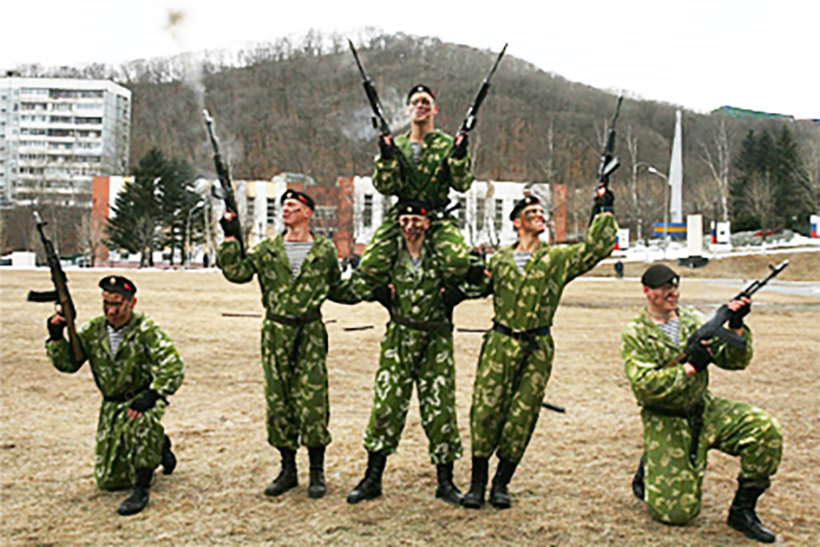
Russian Naval Infantry.

Russian Naval Infantry.
“The current world tectonic events require a significant strengthening…of the Naval Infantry of the Russian Navy.”
At the beginning of Russia’s 2022 invasion of Ukraine, Russian Naval Infantry included five brigades and one regiment. During the invasion, Russia has formed at least three more naval infantry battalions from volunteers and mobilized personnel, trained based on existing naval infantry formations such as the 155th Guards Naval Infantry Brigade in Primorye.[i] In late December, Russian Defense Minister Sergei Shoigu announced a large expansion of the Russian Armed Forces, including the addition of 12 new divisions. Five of these new divisions will be formed by converting five naval infantry brigades into naval infantry divisions.[ii] The accompanying excerpted article from the pro-Kremlin daily newspaper Izvestiya states that these new naval infantry divisions will consist of two naval infantry regiments, a tank battalion, reconnaissance battalion, artillery regiment, and unmanned aerial vehicle (UAV) battalion. The naval infantry regiments in the divisions will likely resemble the 177th Naval Infantry Regiment subordinated to the Caspian Flotilla, consisting of three battalions, an airborne reconnaissance company, UAV company, artillery, and other units. These divisions will be much smaller than equivalent U.S./NATO echelons, likely having less than 5,500 personnel per division when fully staffed.
Sources:
Dmitry Boltenkov,“Морскими темпами: как изменится структура черных беретов в ближайшие годы (At the Sea’s Pace: How the Structure of Black Berets Will Change in the Coming Years),” Izvestiya (Pro-Kremlin daily newspaper), 3 January 2023.
The current world tectonic events require a significant strengthening, first of all, of the Naval Infantry of the Russian Navy. On December 21, 2022, Defense Minister Sergei Shoigu announced plans to form five Naval Infantry divisions.
In 2018, the 177th Naval Infantry Regiment was created in Kaspiysk to support the Caspian Flotilla. It consists of three battalions, an airborne reconnaissance company, UAV company, artillery and other units. Most likely this promising regimental structure will be basis for future naval infantry regiments…
In Kamchatka, the 40th Krasnodar-Kharbinskaya twice Red Banner Brigade is practically the only formation capable of resisting the attempts of a potential enemy to seize this remote territory… In Primorye, the 155th Guards Brigade is also, in fact, the only large formation in the Vladivostok region capable of defending the region and participating in counter-landing operations on Sakhalin Island and the Kuril Islands… In the north, on the Kola Peninsula, Russia currently has only three brigades: the 61st Kirkenesskaya Red Banner MP, the 200th motorized rifle and Arctic brigades. Sweden and Finland finally decided to break with their neutrality and join NATO. Accordingly, Russia will have to strengthen its northern borders. The 336th Guards Brigade and a number of other units of the coastal troops of the Baltic Fleet are deployed in the Kaliningrad exclave. The exclave is surrounded by the most hostile NATO states to Russia – Poland and the Baltic states. In 2023, we should expect the integration of parts of the DPR and LPR into the Russian Armed Forces. It is possible that the Black Sea division of the Naval Infantry will be deployed on the basis of these units. And in general, the situation in the Ukrainian direction for many years will require the presence of powerful forces capable of also conducting amphibious assault operations.
Do not forget the fact that on long-distance cruises there are groups of Naval Infantry on warships and auxiliary vessels to defend these units themselves from enemy saboteurs. With the increase in the naval fleet and the intensification of the Russian Navy’s combat service, more Naval Infantry are required to defend our ships.Thus, at present there is a direct need for Russia to increase the number and power of its amphibious strike formations. Even now such work is underway. So, for example, in the brigades of the Naval Infantry of the Pacific Fleet operating in the Donbass, 152-mm artillery systems are observed, these systems were not previously in service with the Naval Infantry units. The divisions themselves, presumably, will look like this: two regiments of naval infantry, tank battalion, reconnaissance battalion, artillery regiment, and UAV battalion…
Notes:
[i] Russian Naval Infantry have been active in Ukraine since the first day of Russia’s 2022 invasion. The Naval Infantry reportedly conducted a successful landing in Berdyansk and was involved with the taking of Mariupol. Russian sources also claim that the possibility of a landing of Black Sea Fleet Naval Infantry units near Odessa, which never materialized, was successful in the sense that many Ukrainian forces were fixed for a time to defend against the landing, providing freedom of maneuver for other Russian forces. Naval Infantry units were also active around Kyiv, Kharkov, and Pavlovka. Eight Naval Infantrymen have earned the title “Hero of Russia,” some posthumously, since the onset of the conflict. The honorary title of “Guards” was bestowed on the 155th Naval Infantry Brigade of the Pacific Fleet, and the 336th Naval Infantry Brigade of the Baltic Fleet was awarded the Order of Zhukov. The 810th Naval Infantry Brigade reportedly requested to have “Mariupol” added to its official unit title due to its role in supposedly liberating the city.
[ii] The Naval Infantry has been reorganized many times since its inception in 1705. The most recent organization occurred during the “New Look” reforms, resulting in each Russia’s four fleets having its own Naval Infantry brigade (although the Pacific Fleet has two Naval Infantry brigades). By 2017, the standard structure of Naval Infantry brigades consisted of a reconnaissance battalion, an air assault battalion, one or two naval infantry battalions, an artillery battalion, a tank battalion or company, a UAV company, a sniper company, and a few other units.
Image Information:
Image 1: Russian Naval Infantry
Source: https://tinyurl.com/47f4pcny
Attribution: CC BY-SA 4.0
Image 2: Russian Naval Infantry
Source: https://tinyurl.com/47f4pcny
Attribution: CC BY-SA 4.0
Chinese-Arab Summit Signals Growing Saudi-Chinese Defense Alignment
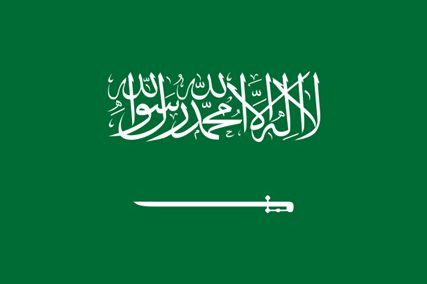
Flag of Saudi Arabia.
“… Saudi Arabia spent $1.4 billion (5.1 billion riyals) in incentives to boost its local military sector over the last two years …”
Much of the Saudi reporting and commentary on Xi Jinping’s December 2022 visit to Riyadh highlighted the visit as a turning point in the birth of a new, multipolar world order. Commentators in Saudi media consider the kingdom a key player in this new world order, one that can maintain good relations and effectively balance between competing poles of global power to safeguard its own national interests. In this view, as articulated in the first accompanying excerpt from the influential Saudi daily al-Sharq al-Awsat, expressions of deepening Saudi-Chinese relations do not by definition threaten the Saudi-U.S. security partnership, but rather are signals of engagement “based on common interests.”
Statements and agreements from the Saudi-organized Chinese-Arab summit revealed a growing alignment of Saudi and Chinese defense priorities that could put pressure on a key pillar of the Saudi-U.S. strategic partnership—arms sales. For now, China seems in no position to surpass the United States as a Saudi weapons supplier: between 2000-2019, the United States accounted for 60 percent of Saudi arms imports by value, while Chinese arms constituted less than 1 percent.[i] The fact that no weapons deals were signed or even publicly discussed during Xi’s visit to Riyadh indicates that arms trade is not yet a priority in the Saudi-Chinese relationship, although this may also be because the two sides had reportedly signed a blockbuster arms deal at the Zuhai Air Show only one month before the summit.[ii]
From the Saudi perspective, reducing its arms imports has become a key priority. In recent years, Saudi Arabia has begun shifting its defense priorities to better align with the kingdom’s “Vision 2030,” which includes localizing weapons manufacturing and developing an indigenous, high-tech national defense industrial base.[iii] As noted in the second accompanying excerpt, from the Saudi news channel al-Arabiya, the director of the Saudi military industry’s regulatory body explained that the kingdom has in the past two years channeled $1.4 billion toward “incentives to boost its local military sector.” Speaking at the Saudi 2023 Budget Forum last December, he added that more than half of that money has gone into research and development, mostly in Saudi Arabia’s priority defense production sectors, which include “unmanned systems, radars and cybersecurity.” Thus, it seems likely that licensing agreements and technology sharing, rather than weapons sales, will emerge as a centerpiece in future Saudi Arabian defense partnerships.
Many of the deals signed at the Chinese-Arab summit were memorandums of understanding and other documents of intent expressing a shared vision and approach, rather than contractual agreements. Notable domains where a bilateral shared vision and intent to deepen cooperation were expressed include space, information technology, telecommunications, and artificial intelligence. The two countries also signed a wide-ranging “digital economic partnership,” which covers a vast array of new technologies, detailed in the third accompanying excerpt, from the official Saudi news agency’s press release on the agreement. These various agreements and statements of intent, although not essentially military in nature, will likely bolster a growing partnership in high-tech weaponry such as unmanned systems, and are likely to feed into the kingdom’s broader defense and security efforts over the next decade.
Sources:
“العلاقات السعودية ـ الصينية وحسابات المصالح
Hoda al-Husseini. (Saudi-Chinese relations and the calculation of interests),” al-Sharq al-Awsat (influential Saudi daily), 8 December 2022. https://tinyurl.com/k342vwkd
… Saudi Arabia does not seek to replace the U.S.’s role in the Middle East and stop considering it the main guarantor of regional security; rather, it seeks to find a balance through which it safeguards its own interests. The relationship between Saudi Arabia and the United States is deeper and greater than a crisis with a transient American administration. At the summit, Prince Mohammed bin Salman will prove to the Chinese president that the Kingdom cannot be infiltrated by benefiting from tensions, but rather must be engaged through equal interaction based on common interests.
“Saudi Arabia spent $1.4 bln in incentives to boost local military sector in 2021-22,” al-Arabiya English (influential Saudi news media channel), 12 December 2022. https://english.alarabiya.net/News/saudi-arabia/2022/12/12/Saudi-Arabia-spent-1-4-bln-in-incentives-to-boost-local-military-sector-in-2021-22
Saudi Arabia spent $1.4 billion (5.1 billion riyals) in incentives to boost its local military sector over the last two years, the governor of the sector’s general authority Ahmed al-Ohali said on Monday…
SAMI’s chief executive officer Walid Abukhaled said the company will focus on unmanned systems, radars and cybersecurity in coming years. Both were speaking at a forum in Riyadh on Monday, in the wake of Saudi Arabia’s 2023 budget announcements.
“Saudi Arabia and China Strengthen Strategic Partnership in Digital Economy,” SPA – Saudi Press Agency (official Saudi news agency), 9 December 2022. https://www.spa.gov.sa/viewfullstory.php?lang=en&newsid=2407961
The Kingdom of Saudi Arabia has signed a strategic partnership for cooperation in the fields of digital economy with the People’s Republic of China, as part of the framework of the current official visit of President Xi Jinping of the People’s Republic of China to the Kingdom…The partnership develops a framework for cooperation between the two friendly countries, covering the fields of digital economy, communications and information technology, and promoting research and innovation in the field of emerging technologies, in addition to improving aspects of communications infrastructure, and enabling the growth of digital entrepreneurship through emerging business models such as financial technology and e-commerce. It also covers cooperation in the fields of artificial intelligence, advanced computing and quantum information technology, in addition to robots and smart equipment, and work to develop their technologies and applications for industrial and commercial purposes. Moreover, this partnership memorandum aims at enhancing the two friendly countries’ cooperation in the fields of the modern generation of mobile communications technology and emerging technologies. Within the framework of this partnership, the two sides will also cooperate in the field of digital technology applications and radio frequency spectrum management, in addition to their cooperation in developing and building local capabilities in communication and data centers, developing digital platforms and cloud computing services, and expanding submarine cable projects.
Notes:
[i] “Arms Sales in the Middle East: Trends and Analytical Perspectives for U.S. Policy,” U.S. Congressional Research Service, Updated 23 November 2020, p. 23.https://sgp.fas.org/crs/mideast/R44984.pdf
[ii] Several media outlets reported that Saudi Arabia and China signed a stack of weapons sales agreements worth around $4 billion at the November 2022 Zhuhai Air Show in China, a few weeks before the Saudi-organized Arab-Chinese summit. The deal reportedly included TB001 UAVs, YJ-21 anti-ship missiles, carrier-based hypersonic missile systems, and an anti-drone laser system known as the “Silent Hunter.” A Chinese military analyst cited by the English-language South China Morning Post is bullish on the prospects of growing Saudi-Chinese arms trade. He considers Saudi Arabia to be potentially interested in several Chinese land systems, including tanks, armored vehicles, and artillery—to include long-range rocket artillery. See: “Why is Saudi Arabia looking to China to buy weapons after years of arms deals with the US?” South China Morning Post, 8 December 2022. https://www.scmp.com/news/china/diplomacy/article/3202245/why-saudi-arabia-looking-china-buy-weapons-after-years-arms-deals-us;For more on the “Silent Hunter,” see: Lucas Winter, “Saudi Arabia Turns to China for Low-Altitude Air Defense,” OE Watch, Issue 4, 2022. https://community.apan.org/wg/tradoc-g2/fmso/m/oe-watch-articles-2-singular-format/415161
[iii] For background on Vision 2030’s impact on Saudi military industry and Saudi-Chinese defense industry relations, see: Lucas Winter “Saudi Arabia and the UAE Streamline Military Industry,” OE Watch, January 2020. https://community.apan.org/wg/tradoc-g2/fmso/m/oe-watch-articles-2-singular-format/353022; “Radars and UAVs: Saudi Arabia Taking Steps to Localize Military Industries,” OE Watch, November 2020. https://community.apan.org/search?q=Radars and UAVs%3A Saudi Arabia Taking Steps to Localize Military Industries; “Continued Growth and Development in Domestic High-Tech Military Industries of Saudi Arabia and the UAE,” OE Watch, March 2021. https://community.apan.org/wg/tradoc-g2/fmso/m/oe-watch-articles-2-singular-format/382665; “Will Saudi Arabia’s Domestic UAV Program Slow Get Off the Ground?,” OE Watch, Issue 1, 2022 https://community.apan.org/wg/tradoc-g2/fmso/m/oe-watch-articles-2-singular-format/405136; “UAV Technologies Proliferating in Yemen and Saudi Arabia,” OE Watch, Issue 7, 2022. https://community.apan.org/wg/tradoc-g2/fmso/m/oe-watch-articles-2-singular-format/420430; and “Saudi Arabia Continues Buying Missiles and UAVs From China as Part of Broader Foreign Policy Rebalancing,” OE Watch, Issue 11, 2022. https://community.apan.org/wg/tradoc-g2/fmso/m/oe-watch-articles-2-singular-format/429585
Image Information:
Image: Flag of Saudi Arabia
Source: https://upload.wikimedia.org/wikipedia/commons/0/03/Flag_of_Saudi_Arabia_%28type_1%29.svg
Attribution: Public Domain
Tajikistan and China Deepen Security Cooperation
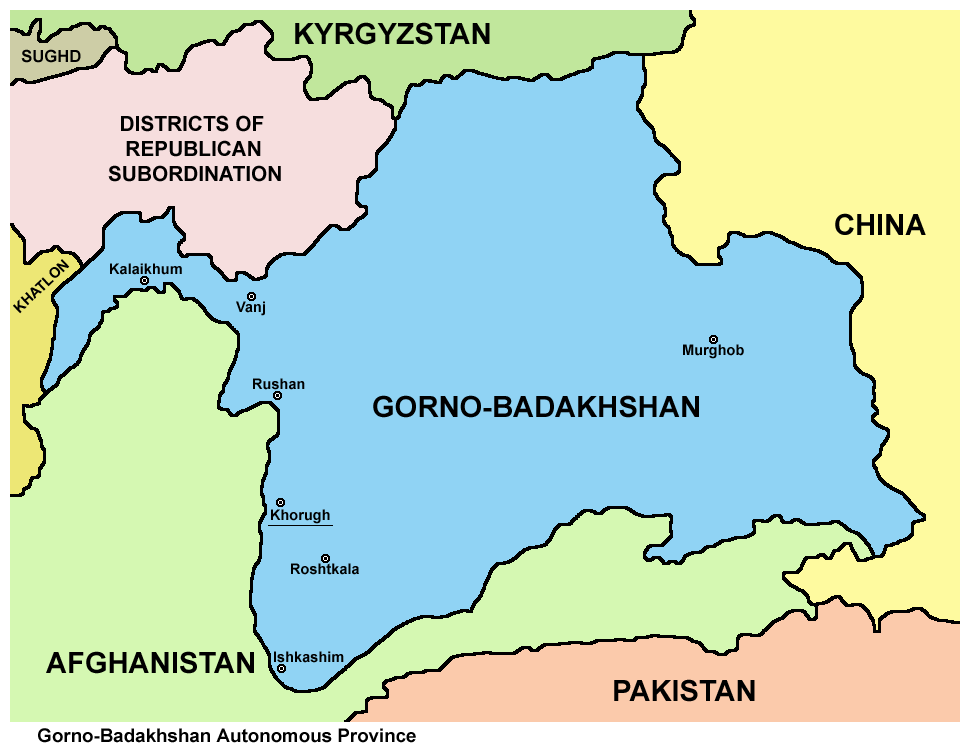
Gorno-Badakhshan map.
“A temporary exercise control department is being created to prepare and conduct the exercises.”
The government of Tajikistan has, in recent years, only rarely released information about its security cooperation activities with China.[i] The accompanying excerpted article from Tajikistan’s independent news website Asia Plus reports on a recent agreement signed by the governments of Tajikistan and China to carry out a series of joint biennial exercises focusing on counterterrorism. While the Tajik government again provided few details about the agreement, there is enough information to gauge how it fits within broader expectations of Tajik-Chinese security cooperation going forward. The article reports that the agreement calls for joint counterterrorism exercises between Tajikistan and China to take place “at least once every two years” and that their purpose is “to strengthen and develop a comprehensive strategic partnership.” The article also mentions that both sides are looking to increase coordination between special forces units as well as tactical skills for counterterrorism. Special purpose units from Tajikistan and China have carried out a handful of joint exercises over the past seven years, all focusing on a counterterrorism scenario, though none of them had been part of a series of exercises.[ii]
The article goes on to note that a “temporary exercise control department is being created to prepare and conduct the exercises” and that both sides will “not disclose details about the timing, location, scale, and leadership of the exercises before the start of the exercise.” It is likely that each side will release some information about future exercises after they take place, but this aspect of the agreement demonstrates how Tajikistan continues to develop a deeper partnership with China. Lastly, the article provides a reminder that China provided 55 million Chinese yuan (around $8 million) last year for a facility for Tajikistan’s Ministry of Internal Affairs in the Gorno-Badakhshan Autonomous Oblast. This new facility appears to be for Tajikistan and is not another Chinese base. Ultimately, Tajikistan’s agreement with China to carry out joint counterterrorism exercises may not appear as significant as Tajikistan’s partnership with Russia, but it does signal a more consistent effort from both sides to develop the partnership.
Source:
Mazhab Juma, “Не реже одного раза в два года. Таджикистан и Китай договариваются, как проводить антитеррористические учения (‘No fewer than one time every two years’. Tajikistan and China agreed to carry out counterterrorism exercises),” Asia-Plus (independent news website in Tajikistan), 21 November 2022.
Tajikistan intends to carry out counterterrorism exercises with China at least once every two years. The text of the agreement between the governments of Tajikistan and China, published on the information and legal portal of the (Tajik) Ministry of Justice), states that the purpose of the exercise is to strengthen and develop a comprehensive strategic partnership.
Another goal is to increase the level of coordination between the special counterterrorism units, the level of interaction between the units, and the training and tactical skills of the two countries…
… It is also noted that a temporary exercise control department is being created to prepare and conduct the exercises… the parties will take strict secrecy measures and will not disclose details about the timing, location, scale, and leadership of the exercises before the start of the exercise.
…in October last year, the Parliament of Tajikistan approved an agreement in which China is building a special base in the Wakhan Gorge of the Gorno Badakhsahn Autonomous Oblast… The base will be built in accordance with an agreement between the Ministry of Internal Affairs of Tajikistan and the Ministry of Public Security of China. “As part of the cooperation agreement between the two countries, China will provide grant assistance for the construction of the base for the rapid response team of the Organized Crime Department of the Ministry of Internal Affairs of Tajikistan…
The cost of building the base is 55 million Chinese yuan (approximately 100 million somoni)…
Notes:
[i] For instance, the 2019 revelation that China had established a base in Tajikistan’s Gorno-Badakshan region near the Tajik-Afghan border only came out after a Western journalist had traveled to the remote region.
[ii] For more information on joint Tajik-China exercises, see: Matthew Stein, “Compendium of Central Asian Military and Security Activity,” 20 January 2022. https://community.apan.org/wg/tradoc-g2/fmso/m/fmso-monographs/360801
Image Information:
Image: Gorno-Badakhshan map
Source: https://commons.wikimedia.org/wiki/File:Gorno_badakhshan_map.png
Attribution: Creative Commons CC0 1.0 Universal Public Domain Dedication
Syrians Fighting for Russia in Ukraine Playing Limited Role

Logo of the Syrian Special Forces, used by the 25th Special Mission Forces Division.
“…the main task of the Syrian fighters was providing security and protection for areas managed by Wagner and other military contractors in Luhansk and Donetsk …”
There have been several reports of Syrian fighters being recruited to fight on the Kremlin’s side since Russia invaded Ukraine in February 2022. A March 2022 report claimed that 40,000 Syrians had been recruited to fight in Ukraine, and early in the conflict Russian officials suggested there were 16,000 Middle Eastern “volunteers” ready to fight alongside Russia. However, as of late 2022, reports place the number of Syrians sent to Russia for training and eventual deployment at around only 2,000. Of those, several hundred were reportedly deployed in September, and another few hundred in November, primarily in “non-combat roles,” according to the first accompanying excerpt, from a report published in the English-language news website Middle East Eye. More specifically, the bulk of Syrian fighters in Russia appear to be associated with the Syrian military’s 25th Special Mission Forces Division, formerly known as the “Tiger Forces.”[i]
Several other Syrian regime loyalist militias have also reportedly provided Moscow with recruits, including the Syrian-Palestinian “Liwa al-Quds” (Quds Brigade), the Iran-backed Afghan-majority Shiite “Liwa al-Fatimiyun” (Fatimid Brigade), militias affiliated with operatives in Syria’s ruling Baath Party, former rebels in the Russia-controlled 5th Division, and fighters recruited by Christian militia leaders from Hama Province.[ii] On 6 November, the Syrian Observatory for Human Rights (SOHR), an opposition NGO, reported in the second accompanying excerpt that Liwa al-Quds fighters had joined fighters from the 25th Division in deploying on the Ukrainian battlefield, without providing details.
The third accompanying excerpt, a December 2022 report from an opposition NGO called Syrians for Truth and Justice, claims that recruitment and transfer of Syrians to fight on behalf of Russia continued through the second half of 2022. Among others, the report details three distinct routes taken by flights suspected of ferrying Syrian fighters to Russia for training. The report also identifies a series of Russian sites where Syrian fighters either train or are stationed, as well as several Ukrainian locations to which they are ultimately deployed, including Kherson, Melitopol, and Donetsk. Per the first referenced entry, the Middle East Eye report, Syrian fighters appear to be mostly providing “security and protection for areas managed by Wagner and other military contractors in Luhansk and Donetsk,” though they may be called to the frontlines if need be. The report mentions a Russian military contractor called “Shchit” (“Shield”) and a Wagner subsidiary known as “Task Force Rusich” as the key Russian entities employing the services of Syrian fighters. As Russia appears to gear up for a new offensive, it seems likely that additional Syrian fighters could be deployed, though based on current trends, their impact will likely remain marginal.
Sources:
“Ukraine war: Russia deploys Syrian fighters to shore up its defences,”Middle East Eye (Qatari-aligned English-language news website), 9 November 2022. https://www.middleeasteye.net/news/ukraine-war-russia-deploys-syrian-fighters
Russia has deployed more than 500 Syrian fighters in Ukraine for primarily non-combatant roles, tasking them generally with safeguarding facilities in Luhansk and Donetsk in the past few months, regional intelligence sources told Middle East Eye…
The official said the main task of the Syrian fighters was providing security and protection for areas managed by Wagner and other military contractors in Luhansk and Donetsk, but they could be called to the front for combat if an emergency or pressing need presented itself…
Those sources told MEE that the Syrians might be serving under the Russian military contractor Shchit (“Shield”) and a Wagner subsidiary group called Task Force Rusich, which earned a reputation for its self-declared neo-Nazi ideology during its deployment to eastern Ukraine in 2014…
However, the Syrian government official said the number of Syrian fatalities was much higher than reported, with at least 50 killed in the Ukrainian bombardment so far. “The Syrians aren’t partaking in the actual fighting, they are mainly functioning as logistics near the front lines. However, there is a small number of them that work as part of the artillery,” the official told MEE.
“Nine Syrian mercenaries killed and Liwaa Al-Quds brigade join war alongside Russians,” Syrian Observatory for Human Rights (opposition Syrian NGO), 6 November 2022. https://www.syriahr.com/en/274960/
Reliable sources have informed SOHR that Liwaa Al-Quds brigade has engaged in fighting alongside the Russians in the Russian war on Ukraine, while the 25th Division has been fighting since mid-September 2022.
“New Testimonies: Russia Continues to Deploy Syrian Mercenaries to Ukraine,” Syrians for Truth and Justice,(opposition Syrian NGO), 20 December 2022. https://stj-sy.org/en/new-testimonies-russia-continues-to-deploy-syrian-mercenaries-to-ukraine/
In this report, Syrians for Truth and Justice (STJ) presents an update on the Syrian mercenary activities in the context of the Ukrainian conflict, revealing new information obtained in December and the second half of November 2022. The information corroborates that Syrian security companies continue to transfer fighters to Ukraine, operating as proxies for the Russian Wagner Group…
Notes:
[i] For background, see: Lucas Winter, “Suheil al-Hassan and the Syrian Army’s Tiger Forces.” Small Wars Journal, Jul 22.9 (2016). https://community.apan.org/cfs-file/__key/docpreview-s/00-00-00-97-25/20160906-Winter-_2D00_-Suheil-al_2D00_Hassan-and-the-Syrian-Army_2700_s-Tiger.pdf
[ii] For background on Syrian militia recruitment and transfers abroad, see: Lucas Winter, “Oil, Fighters, Mercenaries, and Diplomats: Increasing Flows Between Libya and Syria,” OE Watch, April 2020. https://community.apan.org/wg/tradoc-g2/fmso/m/oe-watch-articles-2-singular-format/359091 and Lucas Winter, “Mercenary Recruitment and PMC Growth in Syria,” OE Watch, January 2021. https://community.apan.org/wg/tradoc-g2/fmso/m/oe-watch-articles-2-singular-format/380367; For background on the Quds Brigade, see: Lucas Winter, “The Quds Brigade: Palestinian Militia Emerges as Key Russian Partner in Syria,” OE Watch, November 2020. https://community.apan.org/wg/tradoc-g2/fmso/m/oe-watch-articles-2-singular-format/377063; For background on Syria’s pro-Russian Christian militias in Hama Province, see: Lucas Winter, “Russia Strengthens Ties with Loyalist Christian Militias in Syria’s Hama Province,” OE Watch, March 2021. https://community.apan.org/wg/tradoc-g2/fmso/m/oe-watch-articles-2-singular-format/382766
Image Information:
Image: Logo of the Syrian Special Forces, used by the 25th Special Mission Forces Division
Source: https://commons.wikimedia.org/wiki/File:Syrian_commando.png
Attribution: Jakednb, CC BY-SA 3.0
Morocco Sending Military Equipment to Ukraine
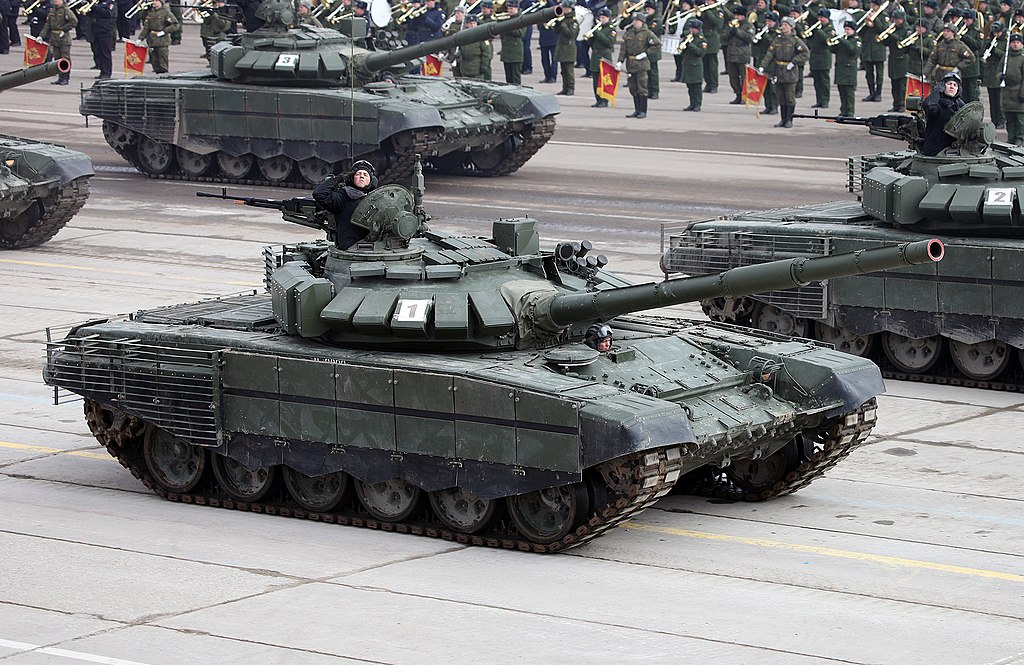
Modernized T-72B3 with additional armor.
“Morocco…will deliver spare parts of T-72 tanks to Ukraine. The kingdom is increasingly taking a stand in the conflict between Kyiv and Moscow.”
New reporting has revealed that Morocco has agreed to send T-72 tanks and tank parts to Ukraine, breaking a stalemate of African states reluctant to take sides in the conflict. As the accompanying article in Le Journal de l’Afrique relays, Morocco agreed to send the tanks and spare parts to Ukraine at the request of the United States.[i] Ukraine had previously asked Morocco for spare parts for its T-72 [R1] tanks in July 2015.
Within a broader geopolitical context, Morocco’s move to support Ukraine with such heavy weapons signals a notable departure among African countries, which so far have largely declined to take a stand in the conflict. Western observers have been notably disappointed that African allies have not been more forceful in their condemnation of Russian moves in Ukraine. Such African neutrality has been most clearly evidenced in UN voting resolutions in March and August, with many African states abstaining from condemning Russian actions, and in other cases, voting against resolutions condemning Russia.[ii] For its part, Morocco abstained from the UN vote condemning Russian aggression in March. However, it remains wary of Russia’s assistance to its neighbor and rival, Algeria, with which it cut diplomatic ties in August 2021.[iii] In contrast, Morocco’s move signals the clearest sign of any African country supporting either side and will likely inform if and how other African countries might decide to take sides in the conflict.
Source:
Frédéric Ange Touré, “L’armement de l’Ukraine par les Américains passe par le Maroc (The arming of Urkaine by the Americans goes through Morocco,” Le Journal de l’Afrique (independent pan-African news outlet), 6 December 2022. https://lejournaldelafrique.com/larmement-de-lukraine-par-les-americains-passe-par-le-maroc/
Morocco, on the recommendation of the United States, will deliver spare parts of T-72 tanks to Ukraine. The kingdom is increasingly taking a stand in the conflict between Kyiv and Moscow.
Last April, the United States was looking for T-72 tanks to deliver to Ukrainian forces in the war between Kyiv and Moscow. These tanks have become a rare commodity in the West… The New York Times indicated, on April 1, that Washington was negotiating with its NATO allies to supply T-72s to Ukraine after the request made by President Volodymyr Zelinski, who sought in particular to solidify his defense in the Donbass. A few days later, we learned that Poland was in the process of delivering 200 T-72 tanks to Kyiv…
The Royal Moroccan Armed Forces have several dozen T-72B/BK type tanks, acquired between 1999 and 2001 from Belarus. In July 2015, the Ukrainian public company Ukroboronservice asked Morocco for spare parts for its T-72 tanks. Kyiv is therefore used to working with Rabat on this subject…
After a statement to recall that Morocco advocates “respect for the territorial integrity, sovereignty and national unity of all United Nations member states”, the kingdom took part in a meeting with 40 allies of the United States, all NATO members and several invited countries, in Germany to discuss increasing military aid to Zelensky’s government.
An alignment with the American position, therefore, the culmination of which is this agreement on the delivery of spare parts for T-72 tanks to Ukraine.
Notes:
[i] Between 1999 and 2001, the Royal Moroccan Army acquired dozens of T-72/BK type tanks from Belarus. Developed in 1972, these Soviet-era tanks have been sold and used throughout the world, especially by former Warsaw Pact countries.
[ii] For more on African stances of the Russia-Ukraine war, see: Jason Warner, “African Stances on the Russia-Ukraine War Demonstrate Reliance on, Antipathy Toward West,” OE Watch 9, 2022. https://community.apan.org/wg/tradoc-g2/fmso/m/oe-watch-articles-2-singular-format/425767 See also: “GCKN Running Estimate: Russian Global Influence Efforts,” December 2022, Update 9. https://community.apan.org/wg/gckn/m/russiaproduct/429266
[iii] For more on Algerian-Morocco relations, see: Lucas Winter, “Algeria Media Dismissive of Morocco-Israel Security Cooperation, OE Watch #9, 2022. https://community.apan.org/wg/tradoc-g2/fmso/m/oe-watch-articles-2-singular-format/425770
Image Information:
Image: Modernized T-72B3[R1] with additional armor
Source: https://commons.wikimedia.org/wiki/File:Alabino05042017-40.jpg
Attribution: Creative Commons 4.0
Nigerian Leadership Seeks Renewed Regional Cooperation Against Boko Haram
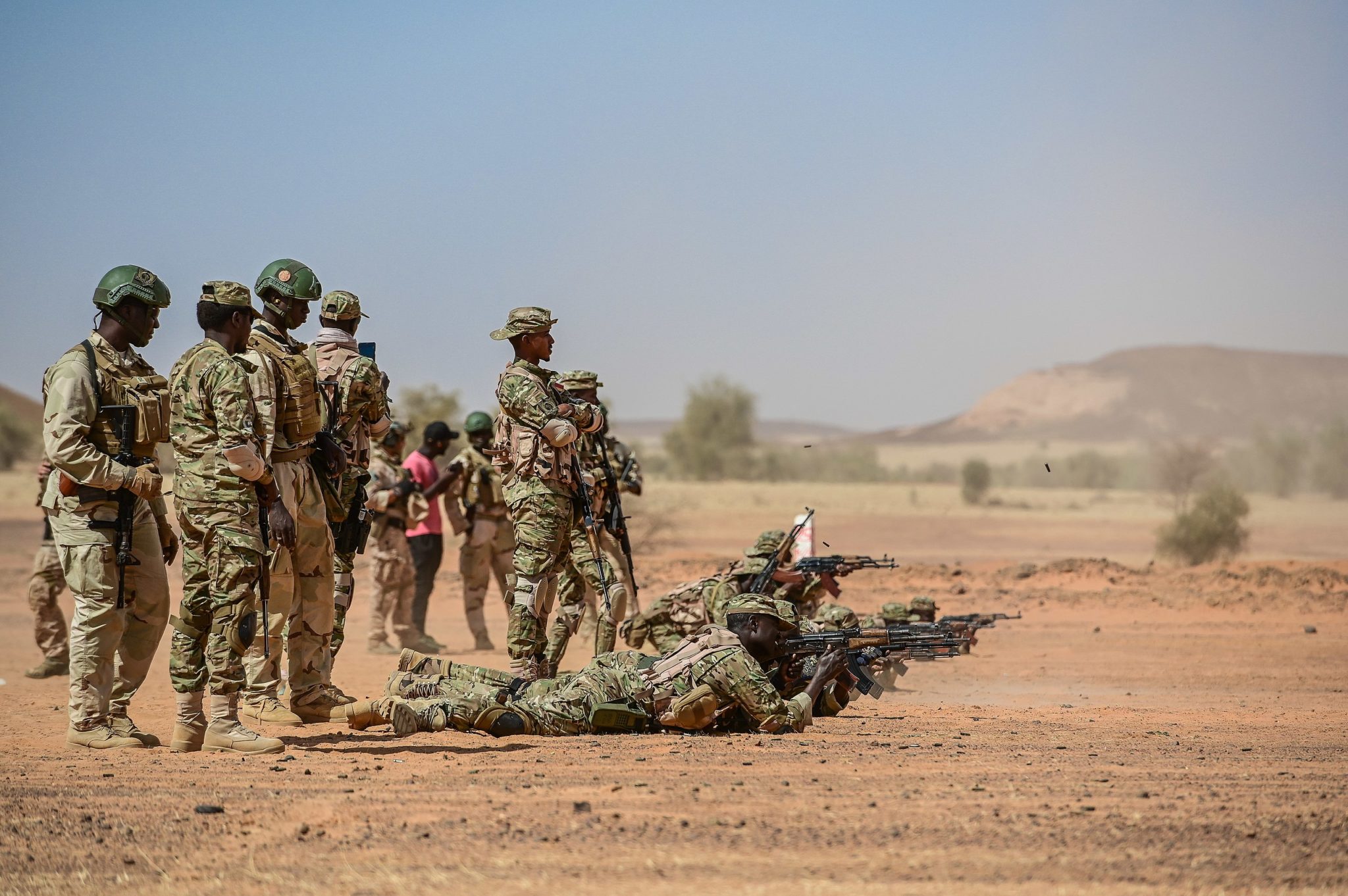
Trigger time at Flintlock 20.
“The operations conducted by MNJTF have seriously degraded the insurgents and there is, therefore, the need to bring all resources together to completely defeat the BHT/ISWAP.”
On 30 November, the business-oriented Lagos-based publication The Nation reported in the excerpted article on Nigerian president Muhammadu Buhari’s speech to heads of state of Multinational Joint Task Force (MNJTF) countries, which include Nigeria, Niger, Chad, Cameroon, and Benin.[i] Buhari argued for greater financial and political commitment to enable the MNJTF to defeat Boko Haram. Prior to Buhari’s speech, on 25 September, the southern Nigeria-based publication This Day, which often reports critically on northern Nigerian affairs, featured the second excerpted article that highlighted the importance the Nigerian army is placing on the MNJTF to combat Boko Haram. According to the article, Nigerian Brigadier General Abdulsallam Abubakar visited the MNJTF headquarters in Chad and, like Buhari, stated that the MNJTF was degrading Boko Haram but additional resources would be needed to finish the job. In particular, Abubakar pointed to the increasing operational tempo against Boko Haram, which comprises two factions around Lake Chad whose mobile bases were largely dismantled during a Chadian-led operation in 2019.[ii]
Although there are other security challenges facing Nigeria, such as banditry and cross-border trafficking, which were the MNJTF mandates when it formed in the 1990s, Buhari urged the MNJTF countries to continue to primarily focus on combatting Boko Haram. This has been the top priority for the MNJTF since Boko Haram launched its insurgency in 2010. The MNJTF was most effective in combating Boko Haram in 2015, but it has since suffered from a lack of coordination, if not also unity of purpose and sufficient resourcing. Ultimately, results will need to be seen on the battlefield in future MNJTF confrontations with Boko Haram along Lake Chad’s shorelines for Buhari’s and Abubakar’s statements to be validated. Their statements nevertheless demonstrate that Nigeria is not conducting a go-it-alone strategy against Boko Haram. Rather, the country considers the contributions of neighboring countries—and specifically the MNJTF—crucial to the military effort.[iii]
Sources:
“Boko Haram: Buhari urges MNJTF to exert final push to end terrorism,” thenationonline.ng (business-oriented Lagos-based daily newspaper), 30 November 2022. https://thenationonlineng.net/boko-haram-buhari-urges-mnjtf-to-exert-final-push-to-end-terrorism/
President Muhammadu Buhari yesterday urged the Multinational Joint Task Force (MNJTF) in the Lake Chad Basin to exert the final push towards ending terrorism in the region. The President said this in his opening address at the 16th summit of the Heads of State and Government of the Lake Chad Basin Commission (LCBC) at the Conference Hall of the Presidential Villa in Abuja. President Buhari, who ended his tenure as chairman of the commission at the end of the 16th summit, also charged his colleagues from the other five member-countries of to provide the requisite political and material support for the LCBC/MNJTF in order to motivate the formations to deliver on their mandates.
President Buhari noted that the fight against Boko Haram terrorists and other forms of threats in the region must remain the lead priority.
“MNJTF Seeks Joint Resource Pool to End Boko Haram, ISWAP Menace,” thisdailylive.com (independent Lagos-based daily newspaper), 25 September 2022. https://www.thisdaylive.com/index.php/2022/09/25/mnjtf-seeks-joint-resource-pool-to-end-boko-haram-iswap-menace/
The Force Commander of the Multinational Joint Task Force (MNJTF), Maj. Gen. Abdul Ibrahim, yesterday called on stakeholders to mobilise resources to bring to an end the menace posed by terror groups, Boko Haram and the Islamic State in West African Province (ISWAP) in Nigeria and the Lake Chad region. The Force Commander spoke as the Chief of Defence Staff (CDS), Gen. Lucky Irabor, said joint training of the armed forces was crucial in dealing with security challenges afflicting the nation…. Speaking in Chad, the Force Commander, MNJTF stated that to effectively bring hostilities in the region to an end and “completely wipe out Boko Haram and ISWAP terrorists in Nigeria and the Lake Chad region,” all stakeholders must pool resources to contain insurgency. He said so far the operations conducted by MNJTF had significantly degraded the insurgents….“The operations conducted by MNJTF and Operation Hadin Kai have seriously degraded the insurgents and there is, therefore, the need to bring all resources together to completely defeat the BHT/ISWAP,” he said.
Director of Army Affairs, Ministry of Defence, Mr. Sunday Attah, affirmed that “the objective of the competition, which is to reinforce the existing cordial working relationship between members of the Armed Forces, has been achieved.”
Notes:
[i] The MNJTF, which is based in N’Djamena, Chad, was originally based in Baga, Nigeria until Boko Haram overran the military base there in 2015. Considering that Boko Haram has gained strength since 2015, the MNJTF is generally not regarded as having succeeded despite winning several battles with the group. In particular, it has been hampered by distrust between the member states. See Albert, Isaac Olawale. “Security Regimes in Africa – Prospects and Challenges.” Africa Development, Vol. 42, No. 3. 2017, pp. 119-135.
[ii] Chad launched Operation Bohoma Wrath against Boko Haram after the terrorist group, led by Abubakar Shekau, massacred roughly 90 Chadian soldiers in the town of Bohoma along the Lake Chad shoreline in a surprise raid in early 2020. For additional information see: United Nations S/2020/373 Security Council, “Joint Force of the Group of Five for the Sahel: Report of the Secretary-General,” May 8, 2020. https://digitallibrary.un.org/record/3861622?ln=fr
[iii] A book chapter on the MNJTF notes that the four MNJTF countries besides Nigeria are incentivized to participate in military operations against Boko Haram to build their own military capacities by receiving training and weapons from foreign armies. In this regard, these countries have tended to seek only limited engagements with Boko Haram on Nigerian territory, but still just enough to assure that the capacity-building of their armies continues. See Emmanuel, Nikolas. “External Incentives and the African Subregional Response to Boko Haram.” African Border Disorders, 1st ed., vol. 1, Routledge, 2018, pp. 136–50. https://doi.org/10.4324/9781315166483-7
Image Information:
Image: Trigger time at Flintlock 20
Source: USAFRICOM from Stuttgart, Germany, https://commons.wikimedia.org/wiki/File:Trigger_time_at_Flintlock_20_(50111204252).jpg
Attribution: CC x 2.0
After New Gains, Somali Government Claims Al-Shabaab Seeks Negotiations
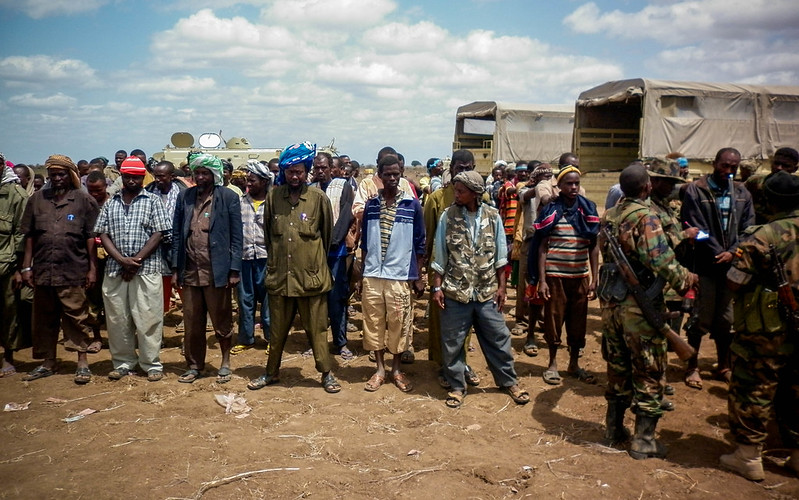
Members of the Al Qaeda-affiliated militant group Al-Shabaab stand after giving themselves up to forces of the African Union Mission in Somalia (AMISOM) in September 2012.
“The army and their allied locals captured the strategic Indian Ocean city of Harardhere, which has been Al-Shabaab’s nerve economic and command center for years.”
Nearly seven months into what Somalia has called a “total war” against the group, the Somali National Army (SNA) has consistently wrested territory away from al-Qaeda’s East African branch, al-Shabaab. Somalia recently claimed that its gains against al-Shabaab have led the terrorist organization to seek, for the first time ever, to negotiate with the government. As articulated in the first article from Shabelle Media, the recent government successes are a result of assistance from the United States, Somali clan militias, increased citizen support, and more draconian measures from the government itself.[i] In January, the SNA captured the port town of Harardhere, an important al-Shabaab economic hub. In the second article from Garowe Online, the Deputy Defense Minister of Somalia, Abdifatah Kasim, proclaimed that al-Shabaab has suggested the idea of negotiations; however, Al-Shabaab members have denied that the group as a whole forwarded such an offer..
Taken together, the above stories are noteworthy in that they potentially signal a rare turning of the tide against al-Shabaab. Indeed, for years the war against Al-Shabab has been at a stalemate despite significant international assistance. Sustained progress might be made if the current gains can be capitalized upon by Somalia and the international community. However, al-Shabaab and al-Qaeda have historically proven to be resilient and the recent gains in no way portends the group’s defeat.
Sources:
“Somali troops dislodge third town from Al-Shabaab in two days,” Shabelle Media (independent Somali/English language news center), 17 January 2023. https://shabellemedia.com/somali-troops-dislodge-third-town-from-al-shabaab-in-two-days/
The war against Al-Shabaab is raging on at a speed time as the Somalia National Army (SNA) and vigilantes take over three towns within two days, a victory that will live long. The minister of defense Abdulakadir Mohamed Nur ticked with a green pen the seizure of the El-Dhere in Galgadud from Al-Shabaab peacefully as the militants fled from their bases.
El-Dher joined dozens of liberated areas in southern and central regions of Somalia during the current all-out offensive assisted by US military and local clan fighters.
On Monday, the army and their allied locals captured the strategic Indian Ocean city of Harardhere, which has been Al-Shabaab’s nerve economic and command center for years.
The latest gains came at no cost of lives as Al-Shabaab leaves every district without posing resistance to the SNA assault. The Al-Qaeda-linked militants carried out ambush attacks against military bases in Hiran and Middle Shabelle regions, where the group faced big losses on the battlefields. The government of Somalia has pledged to liberate the whole country from Al-Shabaab in this year with the support of foreign partners and local communities who joined the war.
“Al-Shabaab extremists deny contact with Somalia’s government,” AfricaNews (pan-African news aggregator), 9 January 2023.
https://www.africanews.com/2023/01/09/al-shabab-extremists-deny-contact-with-somalias-government/
The Somalia-based al-Shabab extremist group has denied having contact with the Somali government after the country’s deputy defense minister claimed that the extremists had for the first time asked to negotiate.
An unnamed al-Shabab official with the group’s media unit told a pro-al-Shabab website in comments published Sunday that “there is no talk between us.”
On Saturday, Deputy Defense Minister Abdifatah Kasim told journalists in Mogadishu that “al-Shabab requested to open negotiations with the Somali government, but there are two groups within al-Shabab.”…
It was the first time Somalia’s federal government had claimed the extremist group had requested talks.
The comments came amid a military offensive the government launched last year and has described as “total war.” Al-Shabab is an al-Qaida-affiliate that for well over a decade has carried out high-profile bombings in Somalia’s capital and controlled parts of the country’s central and southern regions, complicating efforts to rebuild the once-failed state after decades of conflict.
Al-Shabab numbers several thousand fighters, including an unknown number of foreigners, both from regional countries like neighboring Kenya and beyond.
Notes:
[i] For instance, the government of Somalia recently outlawed the reporting about al-Shabaab by media outlets. For more, see: Jason Warner, “Somalia Government Bans Media Reporting on Al-Shabaab,” OE Watch #11, 2022. https://community.apan.org/wg/tradoc-g2/fmso/m/oe-watch-articles-2-singular-format/429366
Image Information:
Image: Members of the Al Qaeda-affiliated militant group Al-Shabaab stand after giving themselves up to forces of the African Union Mission in Somalia (AMISOM) in September 2012
Source: https://www.flickr.com/photos/au_unistphotostream/8019360014
Attribution: Public Domain (CCO)

